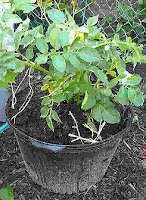I pre-sprouted the fingerlings in an old egg carton in a process know as 'chitting' – a way of creating green sprouts prior to planting - it was recommended to separate by colors and not let them touch each other. They had been mixed when I got them, but I separated by colors. It only took about a week for the fingerlings to begin sprouting in the egg carton. The yellow and red sprouted quickly. The blues didn't sprout but they got planted anyway.
Once they started showing shoots in the egg carton, I planted them in the 3 bags, one bag with the yellow, one bag with the red, and one with the blue. I rolled the bag sides down, like old socks, and filled each with about 6” of garden soil and straw mixture.
From the very start, the yellow fingerlings seem the more robust, with the reds not far behind. The blues are much slower and may not do so well.
After about 6 weeks, it's time to add more soil to the bags to keep the stems covered. And this is the brilliant part: roll up the bags as the dirt is added to keep the stems covered constantly as they grow. When the bag is completely unrolled and filled to the top with soil/straw mix, the stems will have been kept covered to the 'max', which in theory, provides maximum yield. So far everything is going to plan.
I'm not really sure yet when to harvest potatoes, but one source suggested waiting until the top growth is dead, and another source suggests harvest as they grow to induce more tubers. I'm leaning toward the view that its best to just wait until the plants and leaves die completely, which provides maximum energy and growth time to the tubers... and lets face it, it's a lot easier on the harvester too.
[Editor's note: This story is Part 2 of 3 and was written by A. Nonymus.]
 |
| Fingerlings |






